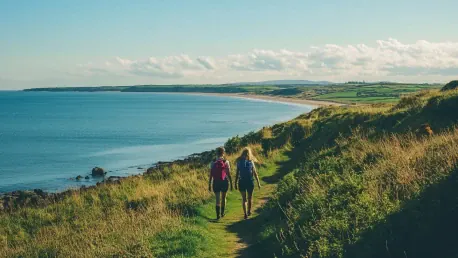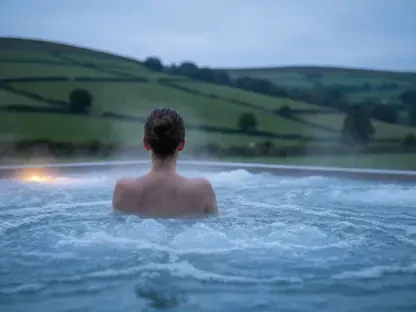Ireland, widely celebrated for its lush green landscapes, is transforming into a paragon of green tourism, positioning itself as a sustainable destination. Tourism Ireland, the organization responsible for marketing Ireland globally, is at the forefront of this transformation, driven by its commitment to environmental sustainability. Alice Mansergh, Tourism Ireland’s CEO, explains how the nation’s natural beauty and dedication to preserving its heritage align with its green tourism ambitions, making Ireland an attractive destination for environmentally conscious travelers.
Journey Towards Sustainability
The Beginning of Sustainable Destination Marketing
Tourism Ireland’s journey towards sustainability formally began in 2018 when the organization adopted sustainable destination marketing principles. This strategy emphasized regional and seasonal tourism distribution, aimed at spreading tourism more evenly throughout the year and across different parts of the country. This comprehensive approach not only alleviated the strain on popular tourist spots but also promoted lesser-known, equally stunning destinations across the island. In 2019, a thorough review of the environmental practices within Tourism Ireland’s offices was conducted to identify areas for improvement.
By 2021, sustainability had become a strategic priority, leading to the development of a detailed sustainability action plan and the establishment of a dedicated internal task force to oversee its implementation. The 2023-2025 corporate strategy of Tourism Ireland further incorporates this focus, seeking to promote growth that is not just economic but also socially and environmentally sustainable. This strategic blueprint aims to foster a tourism model that benefits local communities, conserves natural resources, and reduces overall carbon footprints, setting a high standard for sustainable tourism practices globally.
Balancing Tourism and Environmental Impact
However, the real challenge lies in balancing the influx of tourists with the need to minimize the environmental impact of travel. Recognizing the carbon footprint associated with travel, particularly air travel, Tourism Ireland has honed in on attracting visitors who are likely to stay longer, explore more extensively, and engage deeply with local communities. This strategic move is evaluated using a metric called “revenue per carbon footprint,” which essentially rewards tourism that generates higher economic benefits with lower carbon emissions.
This approach not only incentivizes eco-friendly tourism but also encourages visitors to immerse themselves more deeply in Ireland’s culture and heritage, creating meaningful travel experiences while fostering sustainable practices. By promoting longer stays and responsible travel behaviors, Tourism Ireland aims to reduce the cumulative environmental impact, ensuring that the natural beauty and cultural wealth that draw visitors are preserved for future generations.
Strategies for Sustainable Tourism
Hydrotreated Vegetable Oil (HVO) on the River Shannon
Several key initiatives highlight Ireland’s commitment to sustainability. The boat rental sector along the River Shannon has made a significant shift from fossil fuels to hydrotreated vegetable oil (HVO), drastically reducing carbon dioxide emissions by 92 percent. Where previously, the sector consumed around 500,000 liters of diesel per season, producing about 1.3 million kilograms of carbon dioxide, the switch to HVO has brought emissions down to 107,000 kilograms. This remarkable reduction exemplifies how targeted interventions in tourism operations can lead to substantial environmental benefits while maintaining high service standards for visitors.
Beyond just replacing diesel with HVO, the initiative along the River Shannon represents an integrated approach to sustainable tourism. By partnering with local boat rental companies and promoting the use of cleaner fuel options, Tourism Ireland effectively demonstrates the environmental and economic advantages of adopting green technologies. This initiative serves as a beacon for other tourism sectors to follow, emphasizing the importance of reducing carbon footprints while preserving the quality of visitor experiences.
Greenways: Promoting Slow Tourism
Ireland boasts an extensive network of Greenways—off-road paths repurposed from abandoned railway lines. These Greenways facilitate slow tourism, inviting visitors to cycle or walk through scenic landscapes, which in turn minimizes environmental impact. For example, travelers can take a train from Dublin to Waterford and then cycle along the Waterford Greenway, which features gardens, rivers, and beaches. These Greenways not only offer a sustainable way to experience Ireland’s natural beauty but also support biodiversity and local wildlife, reinforcing Tourism Ireland’s goals of promoting responsible travel.
The development of Greenways has created new opportunities for local businesses, including bike rental shops, cafes, and guesthouses, boosting the regional economy while adhering to sustainable principles. By encouraging visitors to explore at a leisurely pace, Greenways provide a unique and immersive experience that contrasts sharply with the often hectic nature of traditional tourism. This approach fosters a deeper appreciation for Ireland’s landscapes and heritage while minimizing the environmental footprint of travel, making it a cornerstone of Ireland’s green tourism strategy.
Revitalization of Peat Bogs
Historically, peat from bogs was harvested for electricity generation in Ireland, a practice detrimental to the environment. With financial assistance from the European Union, Ireland has transitioned away from peat fuel, focusing instead on the revitalization of its boglands. This transformation has involved developing trails for low-impact tourism, which help sequester carbon and provide new economic opportunities for rural communities. This initiative underscores the broader environmental and economic benefits of preserving natural habitats, contributing to carbon sequestration and biodiverse ecosystems while promoting sustainable tourism practices.
By investing in the restoration and conservation of boglands, Ireland not only addresses its historical environmental impacts but also creates new avenues for eco-friendly tourism. These revitalized areas serve as educational and recreational spaces, drawing visitors interested in learning about peatland ecosystems and their importance in combating climate change. This initiative aligns with global trends towards regenerative tourism, where the focus is on restoring and enhancing natural environments through responsible and sustainable practices.
Fighting Greenwashing
Building Trust with Travelers
One significant challenge in promoting sustainable tourism is greenwashing—the act of misleading consumers with unsubstantiated environmental claims. Mansergh acknowledges this issue and underscores the need for building trust with travelers. Typically, many existing certification programs are based on a pay-to-play model, where businesses earn badges without rigorous scrutiny. This lack of accountability can erode consumer trust and dilute the impact of genuine sustainability efforts.
To address this, Tourism Ireland has taken a proactive stance, emphasizing transparency and accountability in its sustainability initiatives. By fostering open communication and providing clear, evidence-based information about its green practices, Tourism Ireland aims to build and maintain the trust of environmentally conscious travelers. This approach not only enhances the credibility of Ireland’s green tourism efforts but also sets a precedent for other destinations seeking to promote genuine sustainability.
Developing a Reliable Certification Program
To counteract this, Tourism Ireland is collaborating with Fáilte Eire and Tourism Northern Ireland to develop a state-backed, island-wide certification program. This initiative aims to create more transparent and reliable standards for identifying genuinely sustainable businesses, eliminating the reliance on private operators whose certifications might be commercially driven rather than verifiable. By establishing a robust, government-backed certification program, Ireland seeks to ensure that only businesses meeting stringent sustainability criteria are recognized, bolstering consumer trust and supporting authentic green tourism practices.
This certification program will involve rigorous assessments and regular audits to verify the sustainability claims of participating businesses. By collaborating with environmental experts and leveraging advanced technologies, Tourism Ireland intends to create a robust system that accurately reflects the environmental impact of tourism operations. This initiative not only enhances transparency but also provides valuable data to guide future sustainability efforts, positioning Ireland as a leader in responsible and accountable tourism practices.
Outlook and Future Steps
European Union’s Green Claims Directive
Further bolstering Ireland’s green tourism efforts is the European Union’s proposed green claims directive. This directive will establish clear rules for businesses making environmental claims about their products, demanding robust scientific evidence and considering the entire life cycle of a product. It will also standardize environmental labeling schemes, enhancing transparency and credibility for consumers seeking eco-friendly products. By adhering to these stringent regulations, Ireland aims to set a high standard for environmental accountability, reinforcing its commitment to sustainable tourism and inspiring confidence among travelers.
The green claims directive signifies a significant step towards harmonizing sustainability standards across Europe, providing a consistent framework for evaluating and verifying environmental claims. For Ireland, this directive aligns perfectly with its ongoing efforts to enhance transparency and accountability in the tourism sector. By integrating these new regulations into its sustainability strategy, Ireland can further solidify its position as a trusted and pioneering destination for green tourism, encouraging other nations to adopt similar practices.
Connecting with Nature and Tradition
Ireland, renowned for its stunning green landscapes, is evolving into a leader in sustainable tourism. The country is gaining recognition as a top destination for eco-conscious travelers. Tourism Ireland, the organization tasked with promoting the country on the global stage, is spearheading this green revolution. Their commitment to sustainability is the driving force behind this transformation.
Alice Mansergh, the CEO of Tourism Ireland, elaborates on the nation’s efforts to marry natural beauty with the preservation of its cultural and environmental heritage. By doing so, Ireland creates an appealing destination for travelers who prioritize environmental responsibility. The country is not just banking on its picturesque scenery but also its dedicated efforts to remain environmentally friendly.
Eco-tourism initiatives are being implemented across Ireland, providing a variety of sustainable travel options. Whether visitors are exploring the rugged coastlines, hiking through national parks, or enjoying locally sourced cuisine, they can do so knowing the nation is committed to reducing its carbon footprint. Ireland’s approach includes promoting eco-friendly accommodations and green transportation alternatives, ensuring a comprehensive sustainable tourism experience.
With these efforts, Ireland not only highlights its natural allure but also positions itself as a responsible steward of the planet. This commitment to green tourism makes Ireland an irresistible choice for travelers looking to leave a lighter footprint on their journey.









